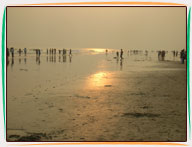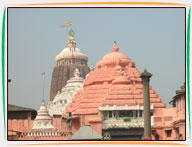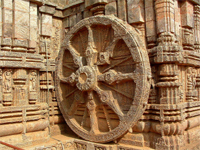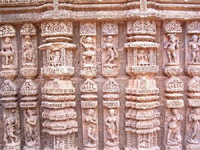Holiday Home at Puri
The features of the holiday home are as under:
 . The hotel is located at the heart of Puri on Marine Parade Road, Sea Beach, Swargadwar with Hotel Sagarica on its right and OTDC, Panthaniwas (Now, Vithal Kamal Restaurant) on its left.
. The hotel is located at the heart of Puri on Marine Parade Road, Sea Beach, Swargadwar with Hotel Sagarica on its right and OTDC, Panthaniwas (Now, Vithal Kamal Restaurant) on its left.. No distance from the Sea at all. On one side of the Road is the Great Bay of Bengal and our Holiday Home is in just opposite of the road.
. Color TV in all the rooms.
. Marble flooring in all the rooms of our Holiday Home.
. Tiled Walls in all the rooms of our Holiday Home.
. Attached Bath in all the rooms.
. Kitchen facility in all the rooms.
. In House Restaurant in the Hotel.
. In case you wish to arrange your cooking yourself, all necessary cooking utensils are provided in all the rooms, starting from Pressure Cooker to Carry Bags to do your shopping.
. The Rooms are equipped with Generator Facility
. Doctor on call facility.
. Arrangement of Sight Seeing by 9 seater/4 seater vehicles can be done on request by the Hotel.
 Tariff: Tariff:With our inaugural offer the tariff of each room for Indian Nationals is Rs.325/- per day. Refundable Caution Money - Rs.100/- per room. For Foreigners, the tariff is $12 per room with the caution money of $5.  How to Book : How to Book :The Holiday Home can be booked directly either at State Bank of India Staff Recreation Club, State Bank of India, Administrative Office, Howrah, 106, Kiran Ch. Singh Road, Shibpore, Howrah - 2. (Opp. Aloka Cinema) Ph: 9433416269, 9903627189 or with Holidayhomeindia, call 9331035550, 9830788403. Distant Booking can also be arranged in case you cannot turn up physically, after getting confirmation from us. You can deposit the total amount at any State Bank of India Branch in account no. 31011854019 favouring SBI Staff Recreation Club, A.O. Howrah A/c - Holiday Home , Ganges Garden Complex Branch or at any branches of Axis Bank in C/A No. 436010200015996 favouring Holidayhomeindia in Barrackpore Branch .  Please note that only cheque deposits are accepted in case of Axis Bank and cash deposit can only be accepted at State Bank of India Branches. An additional charges of Rs.25/- is needed to be added (cash deposit charge levied by the Bank) alongwith courier charges of Rs.15/- to the total booking amount. In case of Cheque Deposits, only courier charges of Rs.15/- may be added. Bookings are subject to clearance of Cheque's. Please note that only cheque deposits are accepted in case of Axis Bank and cash deposit can only be accepted at State Bank of India Branches. An additional charges of Rs.25/- is needed to be added (cash deposit charge levied by the Bank) alongwith courier charges of Rs.15/- to the total booking amount. In case of Cheque Deposits, only courier charges of Rs.15/- may be added. Bookings are subject to clearance of Cheque's. |
Chilika Lake
Konark is one of the well known tourist attractions of Orissa & is one of the important sight seeing from Puri - the sacred city.  Konark or the Sun temple, also known as Sun temple is located amidst a small town named Konark of Puri district of Orissa, India. This masterpiece of Orissa’s medieval architecture is 65 kms from Bhubaneswar and 33 kms from famous tourist destination of Puri. Sun temple was built by Narasimhadeva –I, King of Eastern Ganga Dynasty in the 13th century on the beach of Chandrabagha. The Temple is also referred to as ‘Black Pagoda’ as the entire temple is built with black granite carved in artistic design and is a magnificent example of ancient Orissan temple architecture. This extraordinary example of ancient Kaling architechture was designed in the shape of a colossal chariot with seven horses and twenty-four wheels, carrying the sun god – Surya, across the heavens. Surya being a popular deity in India since the Vedic period. It depicts the joy, grace and the pace of life in its all possible varieties. The temple area is located between longitude 86.08°E and latitude 19.53°N.
Konark or the Sun temple, also known as Sun temple is located amidst a small town named Konark of Puri district of Orissa, India. This masterpiece of Orissa’s medieval architecture is 65 kms from Bhubaneswar and 33 kms from famous tourist destination of Puri. Sun temple was built by Narasimhadeva –I, King of Eastern Ganga Dynasty in the 13th century on the beach of Chandrabagha. The Temple is also referred to as ‘Black Pagoda’ as the entire temple is built with black granite carved in artistic design and is a magnificent example of ancient Orissan temple architecture. This extraordinary example of ancient Kaling architechture was designed in the shape of a colossal chariot with seven horses and twenty-four wheels, carrying the sun god – Surya, across the heavens. Surya being a popular deity in India since the Vedic period. It depicts the joy, grace and the pace of life in its all possible varieties. The temple area is located between longitude 86.08°E and latitude 19.53°N.
Structure of the Temple -
The temple is 229 feet high with the audience hall at a height of 128 feet and the compound area is 857 feet by 540 feet wide. The architecture of Sun temple belongs to the Kalinga School of Indian Temples.
 The word Konark is derived from two separate words ‘Kona’ standing for corner and ‘Ark’ meaning the Sun. The architecture of entire Konark temple is in the form of a Chariot of Surya Devta of ancient Hindu mythology, the God Sun on twelve pairs of minutely designed wheels drawn by seven horses. The major attraction of the Konark temple is the wheels of the chariot which are 10 ft in diameter with intricate architecture & carvings. During the ancient days these wheels were used as tools for watching the time cycle of a day (24 hours) with the shape of the shadow of the wheel depicting the specific time of the day and the seven horses dragging the Chariot represent 7days of a week. The entrance of the temple is guarded by two lions crushing a war elephant. In the entrance there is a Nata or Natya Mandir (Dancing Hall) where the dancers of the temple used to worship God Sun through their dance. The Nata Mandir in front of the Jagamohana is also intricately carved and is of photographer’s preference.
The word Konark is derived from two separate words ‘Kona’ standing for corner and ‘Ark’ meaning the Sun. The architecture of entire Konark temple is in the form of a Chariot of Surya Devta of ancient Hindu mythology, the God Sun on twelve pairs of minutely designed wheels drawn by seven horses. The major attraction of the Konark temple is the wheels of the chariot which are 10 ft in diameter with intricate architecture & carvings. During the ancient days these wheels were used as tools for watching the time cycle of a day (24 hours) with the shape of the shadow of the wheel depicting the specific time of the day and the seven horses dragging the Chariot represent 7days of a week. The entrance of the temple is guarded by two lions crushing a war elephant. In the entrance there is a Nata or Natya Mandir (Dancing Hall) where the dancers of the temple used to worship God Sun through their dance. The Nata Mandir in front of the Jagamohana is also intricately carved and is of photographer’s preference.
The whole temple area is enclosed by different geometric patterns. Around the base of the temple, up to the walls and roof there are sculptures of couples in varied postures of Kamasutra in erotic style. The intricacy & detailing of sculptures of animals, men and warriors, musicians playing drums & different instruments in odissi dance posses on horses in the temple are the examples of magnificence of the Orrisan architecture during that era.
The Archeological Survey of India runs a Sun temple museum where different sculptures of the Konark temple are being displayed. The renowned Nobel laureate Rabindra Nath Tagore once quoted about the Konark that – “here the language of stone surpasses the language of man”. This magnificent example of ancient Indian surviving heritage is declared as World heritage site by UNESCO in the year 1984. There are three images of the Sun God, positioned to catch the rays of the sun at dawn, noon and sunset.
The legendary tale about the Construction of the temple -
According to the ancient belief, the God Sun or Surya Devta used to ride on the divine chariot across the heaven. Another legend says that, King Narasimha Deva-I of the Ganga Dynasty had built this temple as a royal proclamation of the political supremacy of his dynasty against muslim invaders. More than 1200 artisans and architects with their creative talent and artistic sense, took a long period of 12 years to build this architectural brilliance. The expenses for construction of the temple was believed to be equivalent to the 12 years of King Narasimhadeva’s state’s revenue. About 2000 tons of stones were used to build the temple.
According to other legend it was built by Samba, the son of lord Krishna who cursed him with leprosy was cured by the rays of sun during his worship, decided to build Sun temple.
Fall of the Temple –
According to the historians there are several opinions regarding the destruction the Konark temple. One of the reasons believed was the early death of King Langula Narasimha Dev, the builder of the temple. Due to the death of the king the construction of the temple remained incomplete in a haphazard manner which resulted in the collapse of the temple. But this fact was not supported by the other historians as there was a specific record in the Madala Panji of the Lord Jagannath Temple of Puri that the king Langula Narasimha Dev was alive till 1282. A.D and the construction of the Konark temple was completed between 1253 and 1260 A.D.
The other reason may be according to the local belief was that the magnetic dome of temple used to compel ships to crash near the seashore, therefore the dome was removed and destroyed by the Portuguese navigators. Due to its displacement, the temple walls lost their balance and eventually fell down. The original image of the Sun God was taken to Puri. But there is no record of this fact in any historical records.
The most popular theory about the root of the fall of Konark temple is according to the history of Orissa, in 1508 Kalapahad invaded Orissa. He destroyed Konark temple and other Hindu temples in Orissa. Including Konark temple, he destructed most of the images in most of the Hindu temples in Orissa. Though it was impossible to break the walls of Sun temple of Konark which are of 20 to 25 feet (7.6 m) thick, he somehow managed to displace the Dadhinauti (Arch stone) which resulted in the gradual collapse of the temple.
Consequently, in 1568 Orissa came under Muslim control during which there were attempts to destroy the Hindu temples. The Pandas of Konark took away the image of lord sun of the Sun temple and buried it under the sand for years. Latter on the image was said to have been removed to Puri and kept in the temple of Indra, in the compound of the Puri Jagannath temple. According to others, the Puja image of the Konark temple is yet to be discovered. But others hold the view that the Sun image now kept in the National Museum of Delhi was the presiding deity of the Konark Sun temple.
In 1626 the king of Khurda, Raja Narasimha Dev took away the Sun image to Puri along with two other moving deities – Sun and Moon and established them in a temple in the compound of Puri Jagannath temple.The big block of stones called Navagraha Paata placed in front of the Mukhasala were removed by the king of Khurda. The king took away different sculptured stones from Konark and constructed some portions of Puri temple with them. During Marahatta’s time the outer compound wall of the Puri temple was constructed of stones from Konark temple.
The main temple structure was destructed by the natural calamities and the human greed. The three gateway structures were destroyed by the king. The temple structure was engulfed in the huge pile of sand for a long period.
The carcass of the Konark temple was unearthed and brought to the limelight in the late 19th century by the initiatives of the Lord Curzon, which was deserted under the sand for 300 years due to lack of maintenance and negligence. The British Archeologists uncovered the lower portion of the temple structure and restored the ruins of the temple. Although the tower over the Garvagriha was not found but the Jagmohana (Audience Hall) was found intact. A small portions of the Nata Mandir (Dancing Hall) and Bhoga Mandir (Dinning Hall) have survived.
Festivals -
Konark Dance Festival – During the month of December every year annual dance festival of Indian classical forms are held at the Konark temple complex which includes the traditional classical dance form of Orissa – the famous Oddissi form. This dance festival is a very reputed one and esteemed festival for the artists who perform here. Renowned dancers from all over the country come here during this dance festival to participate in the open air auditorium in the temple complex. In this festival the varied dancing forms of different regions in India were performed like Bharathnatyam, Kuchipudi, Manipuri, Kathak, Chau etc. The sound of ghungroo, flute and other classical instruments in the open air auditorium in the backdrop of illuminated Konark temple create the atmosphere very festive. The beats of ‘Raga’ and ‘Tala’ fill the air with the sounds of classical music. The dance festival is organised by the Orissa tourism and Oddissi Research Centre. This dance festival provides a platform both to the famous dancers of the country as well as the new upcoming dancers to dislay their talents through different classical dance forms. During these days a handicrafts fair is also organised around the temple complex where the famous handicrafts of Orissan architectures were displayed and sold. The festival is being organised during the 1st of December to 5th of December every year.
Magha Saptami festival -
The Magha Festival which is also known as Chandrabhaga festival is a famous religious festival held on the Chandrabhaga river in Konark. This week long festival is one of the most biggest festival held in Orissa after the Rath Yatra. Magha Saptami festival is held in the month of February in the honour of lord Surya, the God Sun. During this festival, before dawn millions of devotees gather here to worship God Surya during sunrise. The devotees take a holy dip in the river water which they believe cures their illness. The spiritual benefits of this holy bath are compared equal to that of holy bath in the Ganges. During this festival a mela is arranged in the area.
How to get there –
You can visit Konark during any time of the year, as it has a favorable climatic condition throughout the 12 months period.
Airport – There is no direct connection to Konark by air. . The nearest airport is at Bhubaneswar, 65 kms away.
Indian Airlines, Jet Air, and Sahara connect Bhubaneswar to Delhi, Calcutta, Madras, Hyderabad, and Nagpur.
Rail- The nearest railway station is Puri which is 33 kms away and Bhubaneswar is 65 kms from Konark. These two railway stations are connected to all the major cities in India through long-distance trains.
Road – Konark is connected by road with both Bhubaneswar & Puri . It takes 2 hours fro Bhubaneswar to reach Konark and less than a hour from Puri. One can visit Konark temple from Puri by taxi also. Orissa State Road Transport Corporation and private buses ply from all parts of the state. Deluxe coach services from Calcutta, Bijapur, and Vishakhapatnam are available.
Local watchables –
Chandrabhaga - 3.5 Km from Konark Temple, this beach is rated as one of the finest beaches with clean sand and deep blue sea water. During the clear sky the golden sunrise on the blue sea waters is a life time experience to watch. During Magha –Saptami in February-March people take holy bath in the sea water.
Ramachandi - 8 Km away from Konark Temple, Ramachandi Temple is on a beautiful spot on the banks of the Kusabhadra River where it flows into the Bay of Bengal. Goddess Ramachandi, is the temple of Mayadevi, wife of Sun god. The temple of Goddess ‘Ramachandi’ on the river mouth of Kushabhadra river is a splendid scenic picnic resort.
Astaranga - Right on the Sea-shore, it is 91 kilometers from Puri and 10 kilometers from Kakatapur. Astaranga presents a panaromic view especially during sunset on a multi-coloured horizon as if to justify the literal meaning of its name. It is a center of salt production and fishing.
Pipli - On the way to Konark, Pipli is famous for its exquisite applique work. In Pipli the colourful garden and beach umbrellas, shoulder and hand bags, awnings, canopies etc are made which depict the essence of Oriya culture. The beautiful & artistic products made up of blend of different colourful pieces of clothes stitched together look gorgeous.
Kakatapur – it is 45 kms away from Konark situated in the Prachi valley. This place is famous for the shrines of Goddess Mangala & Banadurga. The legend about this place is that the direction for reaching the holy log from which is created Lord Jagannath’s icon comes from her. In the month of April-May every year famous “Jhamu Yatra” is being held where the patuas or devotees of lower castes walk through a narrow passage hot charcoal to display the extreme devotion to God.
Bhagabati Temple, Konark – 2 Km from Konark Temple
Chilka -70 Km from Konark Temple
About Me
- fanoosh
Labels
- berhampore (1)
- bhubaneswar (3)
- brahmapur (2)
- chandipur (2)
- chilika (3)
- chilka (2)
- gopalpur (3)
- holiday home (1)
- holidayhome (1)
- jagannath temple (3)
- konark (2)
- puri (3)
- sea (3)
- sea beaches (3)
- sun temple (2)











